Physical Address
304 North Cardinal St.
Dorchester Center, MA 02124
Surgeries to correct changes in the eyelids and forehead area that are secondary to aging and manifest by redundancy and displacement of tissues. The most important procedures include upper and lower eyelid blepharoplasty and brow elevation.
Facial aging results in bone remodeling with changes in soft tissue draping and midface fat atrophy.
Any aesthetic eyelid or brow surgery must evaluate the patient’s complaints and goals.
Detailed examination is mandatory to uncover specific anatomical abnormalities that need to be addressed.
When brow and eyelid surgery are planned, the brow should be elevated first to avoid removing too much upper eyelid skin.
Aging changes in the face involve progressive remodeling of the facial skeleton with bone projection in the forehead and brows and facial regression in the midface and lower face. Loss of collagen and elastin in the various layers of the skin and subcutaneous tissues are seen in the eyelids and midface. Changes that occur in the upper eyelid skin are compounded as a result of passive stretching, loss of support, or redundancy of skin secondary to lowering of the brows.
Most patients do not appreciate the extent to which brow malposition contributes to the overall appearance of the aging periorbital area. This needs to be pointed out specifically to help them understand why a blepharoplasty alone often will not fully correct the problem. If a manual lift of the brow to the desired position significantly improves the patient's appearance, a browplasty—either alone or combined with blepharoplasty—should be considered. If a blepharoplasty is performed without recognizing any associated brow ptosis, the lateral eyebrow can appear pulled down, which produces an undesirable, sad appearance.
Key anatomical features that cause excess upper eyelid skin include brow ptosis from the loss of forehead deep tissue support, loss of the deep invagination of the eyelid skin in the principal lid crease as a result of anterior displacement of the suborbicularis fat pads, and stretching of attachments between the levator aponeurosis and the skin. For the sake of understanding the anatomy, the lid may be divided arbitrarily into two distinct portions ( Fig. 12.15.1 ).
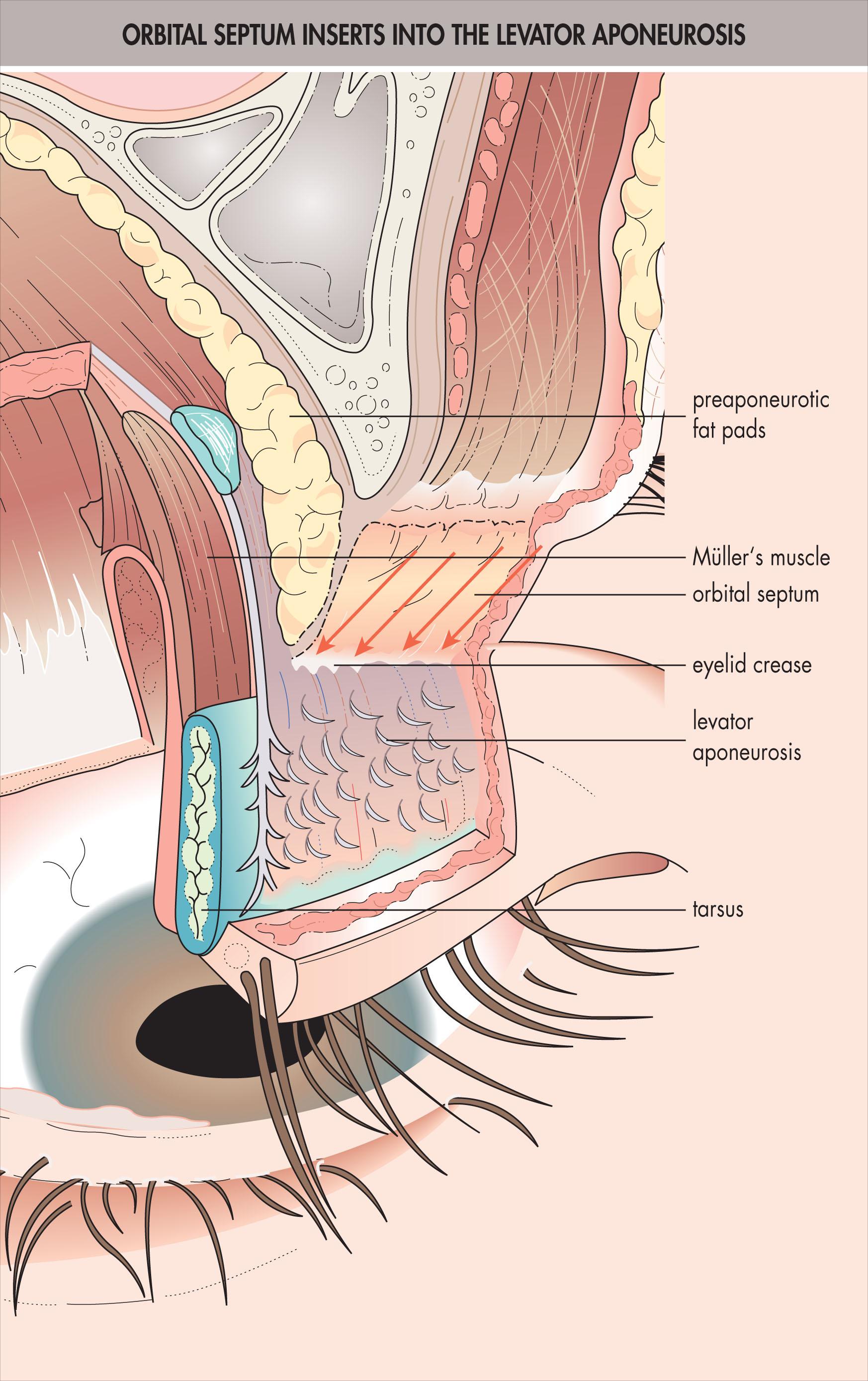
Anatomy of the upper eyelid is discussed in Chapter 12.1 . The eyelid crease is an important anatomical and aesthetic landmark. The skin and muscle between the crease and the brow form the eyelid skin fold. If upper lid fat recedes or the levator aponeurosis becomes stretched or disinserted, the crease assumes a higher position. In the Asian eyelid, the crease (if present) is lower because of the low insertion of the orbital septum into the levator aponeurosis with consequent descent of the preaponeurotic fat pockets.
When the eyelid opens, the lid crease skin is pulled upward and backward by the aponeurosis as it retracts under the fat pads ( Fig. 12.15.2 ). The eyelid skin fold then bulges slightly as the fat pushes the skin forward. During downgaze, tension in the aponeurosis becomes lax, resulting in a weakened or absent lid crease.
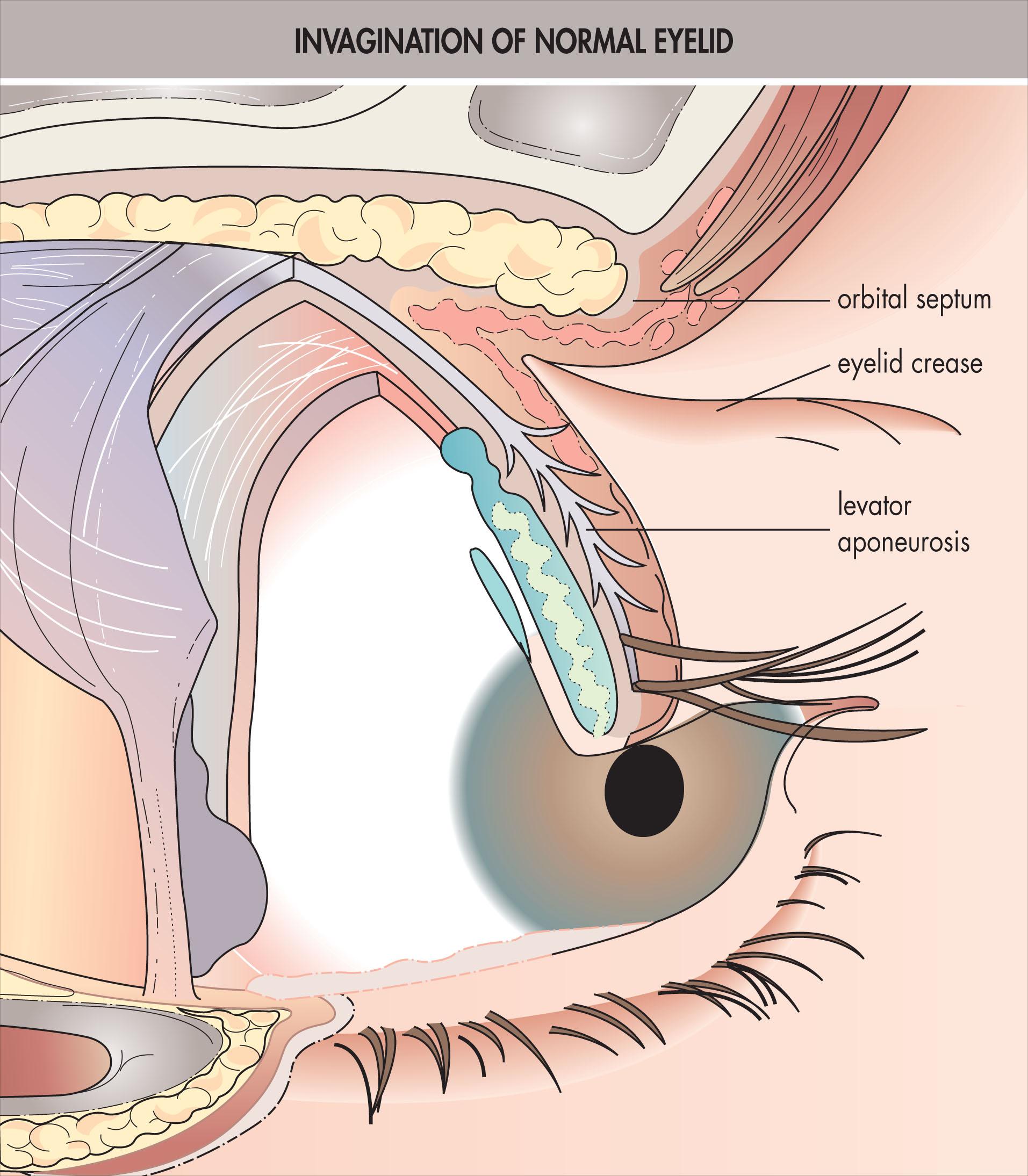
The lower eyelid has a similar but simpler anatomy and is reviewed in Chapter 12.1 . Integrity of the medial and lateral canthal tendons is very important to maintain a proper lid position, especially in the aging face. However, the bony configuration of the midface also plays a key role. Because the lower eyelid is less mobile than the upper, less redundancy of the skin and orbicularis muscle occurs. The major aging changes include sagging of skin, deepening of wrinkles and of the medial tears trough, descent of the lateral canthus from loss of bony support, and atrophy of the lower eyelid fat pockets.
A thorough understanding of the forehead anatomy is essential to evaluate brow ptosis ( Fig. 12.15.3 ). The layers in the midforehead are skin, dermis, superficial galea, frontalis muscle, deep galea, and periosteum. The forehead skin is much thicker than the eyelid skin. The dermis and subcutaneous fat are connected to the underlying frontalis muscle by multiple fibrous septa. The paired frontalis muscles originate just anterior to the coronal suture line, and a smooth fibrous sheath, the galea aponeurotica, envelops the muscle to form both superficial and deep galeal layers.
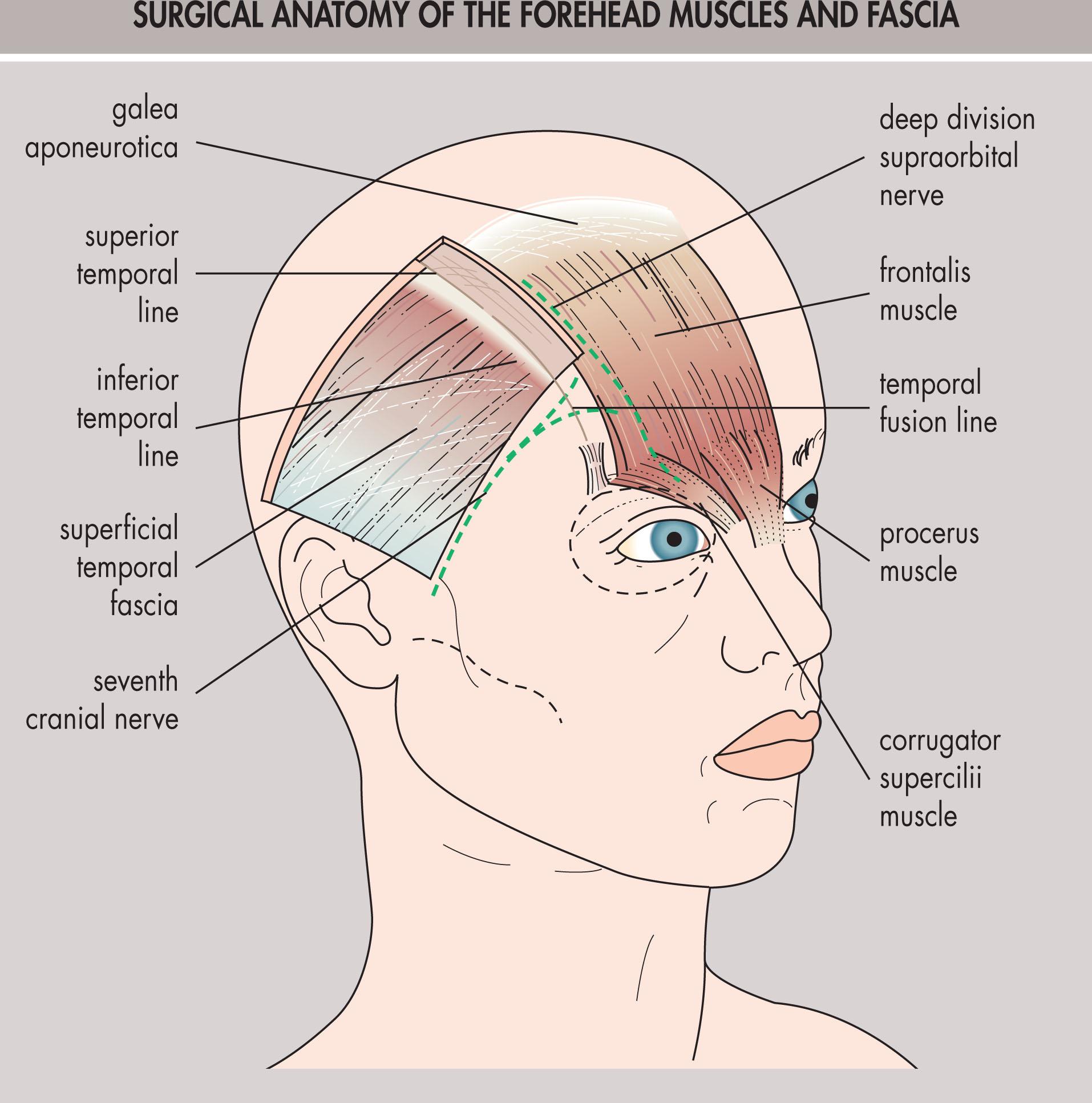
Laterally, the frontalis muscle ends and does not extend beneath the lateral third of the brow. Here the superficial galea, the superficial temporalis fascia, and the periosteum of the frontal bone fuse. The confluence of these tissue planes is called the “zone of fixation.” The eyebrow fat pad (subgaleal fad pad) is a transverse band of fibroadipose tissue 2–2.5 cm above the orbital rim. It allows movement of the frontalis muscle in the lower forehead.
Medially, the procerus muscle is continuous with the medial portion of the frontalis muscle and inserts into the nasal bone and glabellar subcutaneous tissue. It causes horizontal wrinkles of the glabella. The corrugator supercilii muscle is obliquely oriented, passing from the subcutaneous brow to the frontal bone medially. It causes vertical glabellar furrows.
Several important neurovascular structures occur in the forehead. The frontal branch of the facial nerve lies within the superficial temporal fascia before entering the deep surface of the frontalis muscle. Several nerves are found along the superior orbital rim: the lacrimal nerve laterally, the supraorbital nerve with its deep and superficial divisions centrally, and the supratrochlear nerve more nasally.
Several factors contribute to the appearance of the aging forehead and brow. These include changes in the quality of the skin, loss of tissue support, and horizontal forehead and glabellar furrows related to action of the underlying facial muscles. The lateral eyebrow segment is more prone to becoming ptotic because of less structural support in this area. The final brow position depends on the dynamics between the frontalis muscle pulling the brow up and the descending temporal soft tissue and lateral orbicularis muscle dragging it down.
When evaluating patients who seek cosmetic improvement of the periorbital area, the surgeon should understand the patients' motives for undergoing surgery and the decision-making process they have undertaken. Asking patients what they expect the surgery will change for them can sometimes reveal unexpected motives or unrealistic expectations. The psychological screening should include a medical and surgical history with specific questions about previous cosmetic surgery. Outcomes of previous surgeries might give a clue to unrealistic expectations, especially if the objective results of these previous surgeries are not in harmony with the patient's perception. Previous mental illness should alert the surgeon—a psychiatric consultation is sometimes useful.
In assessing expectations, the surgeon can help by carefully discussing the surgery and explaining the improvements to be expected. It is important to detail the cosmetic defects that cannot be changed by surgery and establish a realistic plan for facial rejuvenation.
The patient is asked to consider carefully the decision to undergo surgery and, if one is sought, should be encouraged to obtain a second opinion. Establishing a relationship of trust is of paramount importance. If in any doubt, even for unclear objective reasons, a conservative attitude is recommended.
The position and shape of the different periorbital structures are evaluated along with the quality of the skin. In the forehead area the level and shape of the hairline, the quality of skin of the forehead, and the position and shape of the brows are evaluated with specific attention to detecting brow asymmetry. The muscular layer is judged by looking at the frown lines in the forehead and glabellar area and by asking the patient to relax the forehead. The bony orbit is then evaluated, especially laterally at the orbital rim, where some prominence can mimic lacrimal gland prolapse. This is a good time to evaluate the position of the globe in relation to the bony orbit, because this is an important determinant of the type of lid fold to aim for. A fuller orbit with a large eye leads to a convex upper eyelid above the crease, whereas a large orbit with a small eye results in a more concave upper lid above the crease. A prominent globe with recessed zygoma often leads to lower lid malposition.
For the eyelids, precise measurements of the eyelid vertical and horizontal apertures should be recorded, noting the high point of the upper lid both from the lower lid and from the midpupil. The general shape of the palpebral fissure is noted. The position of the lid crease and upper eyelid skin fold should be documented. The amount of fat to be removed in all fat pad areas is estimated, and any prolapse of the lacrimal glands is noted. In the lower lids the fat pads are carefully assessed, with any areas of prolapse noted. The inferior periorbital area over the upper cheek is evaluated in a similar fashion. The quality of the skin is important, and cicatricial changes from dermatological conditions or chronic sun exposure can make the lid more susceptible to malposition after surgery. The cheek is examined for the presence of festoons, noting whether they consist of only skin and orbicularis muscle or also of suborbicularis fascia and/or orbital fat. The lower lid is assessed with the distraction test by pulling the central lower lid margin away from the eye. A distance of more than 6 mm is considered abnormal and may require a lift tightening. The position of the lateral canthus is noted and normally is 1–2 mm higher than the medial canthus. As an aging phenomenon, the lateral canthus is often lower. Laxity of the canthal tendons is noted and if present is manually tightened with the finger before estimating the amount of skin to be removed. The nasojugal area should be examined to detect tear trough deformities, which may need correction instead of fat pad removal.
The use of a flow sheet to outline systematically the physical findings is an excellent way to plan present and future surgery. Surgical planning must take into account the patient's desires, what he or she is willing to undergo, and what the surgeon thinks is reasonable and safe. Fig. 12.15.4 gives an overview of the patient consultation evaluation for blepharoplasty and correction of any brow malposition. A good set of photographs should carefully document the changes noted and must be kept as part of the patient's medical record.
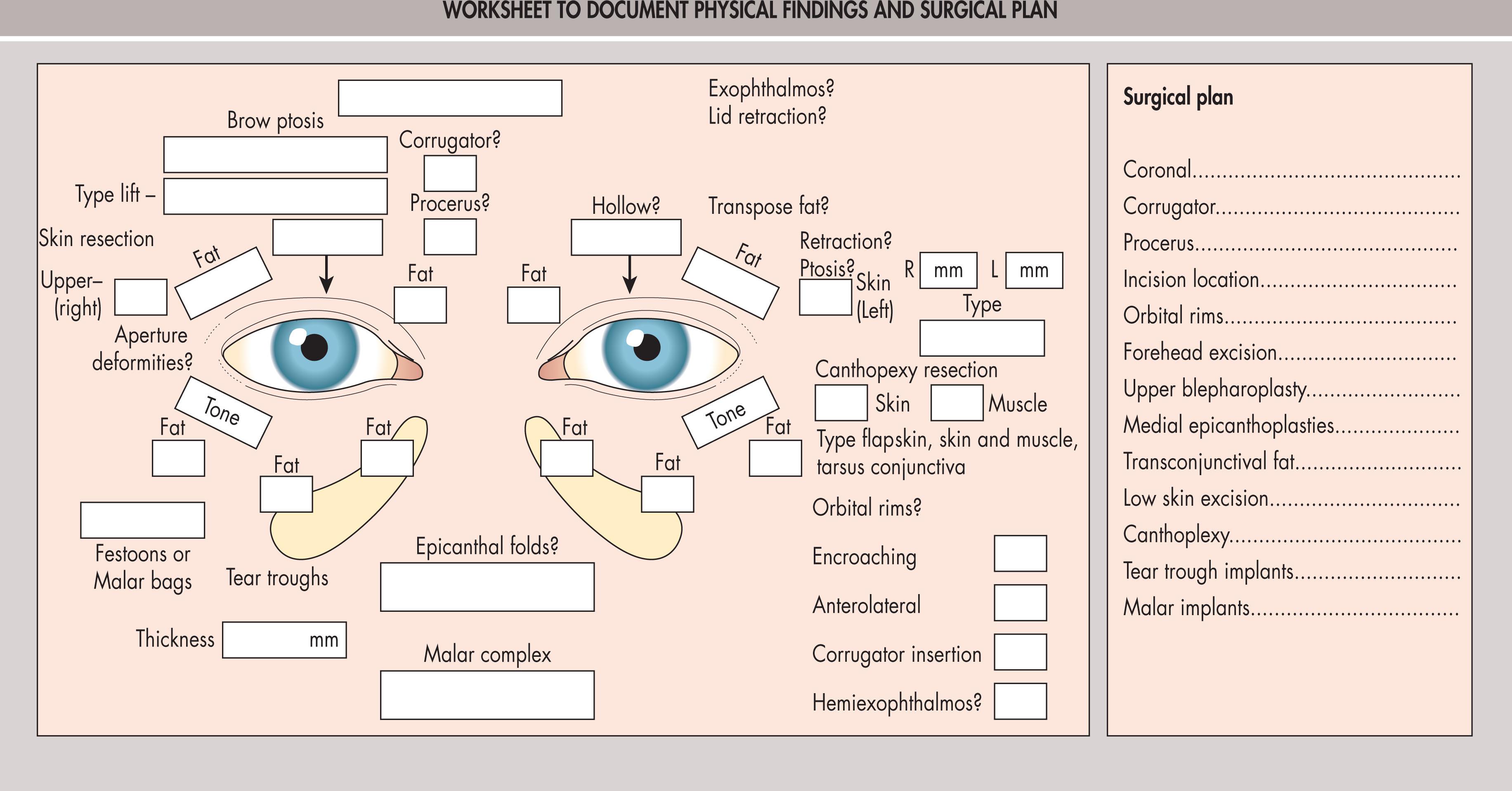
Local infiltrative anesthesia containing epinephrine for hemostasis is adequate for all blepharoplasty procedures. Some surgeons prefer a supraorbital and supratrochlear nerve block.
Draping should be done carefully to avoid distortion of the brow and lateral canthi and to allow the patient to sit up, if necessary, during the operation. The amount of skin to be removed is marked before infiltration of anesthetic, which will distort the tissues. In the upper eyelid, excessive removal of thin lid skin may result in a dragging down of thick brow skin and should not be substituted for first repositioning the brows. In the lower lids the same principle applies: the lid should be repositioned and the scleral show corrected with appropriate lateral canthal surgery before any skin is removed.
Before upper eyelid blepharoplasty is begun, the brow should be repositioned as needed, especially lateral brow droop. A proposed skin incision is marked in the existing eyelid crease, or if there is no visible crease, the line is marked about 8–10 mm above the lash line, taking into account the racial background of the patient. The crease marking usually goes from a point above the superior punctum to—but not beyond—the lateral orbital rim. Skin excess is evaluated by placing one arm of a forceps on the crease incision line and pinching the redundant skin within the opposite arm so that in downgaze the skin is tight without lagophthalmos. In general, 20–24 mm of skin should be left between the brow and the lid margin to prevent postoperative lagophthalmos. The long-taught rule that the eyes should not close on the operating table has certainly become obsolete. Excessive skin removal medially may result in hood formation. If disproportionate tissue is still present in this region after surgery, a glabellar lift can be considered. An optional small triangular flap of skin can be added to the usual skin pattern medially to minimize folding of the skin at the time of closure in patients with excess of skin medially ( Fig. 12.15.5 ).
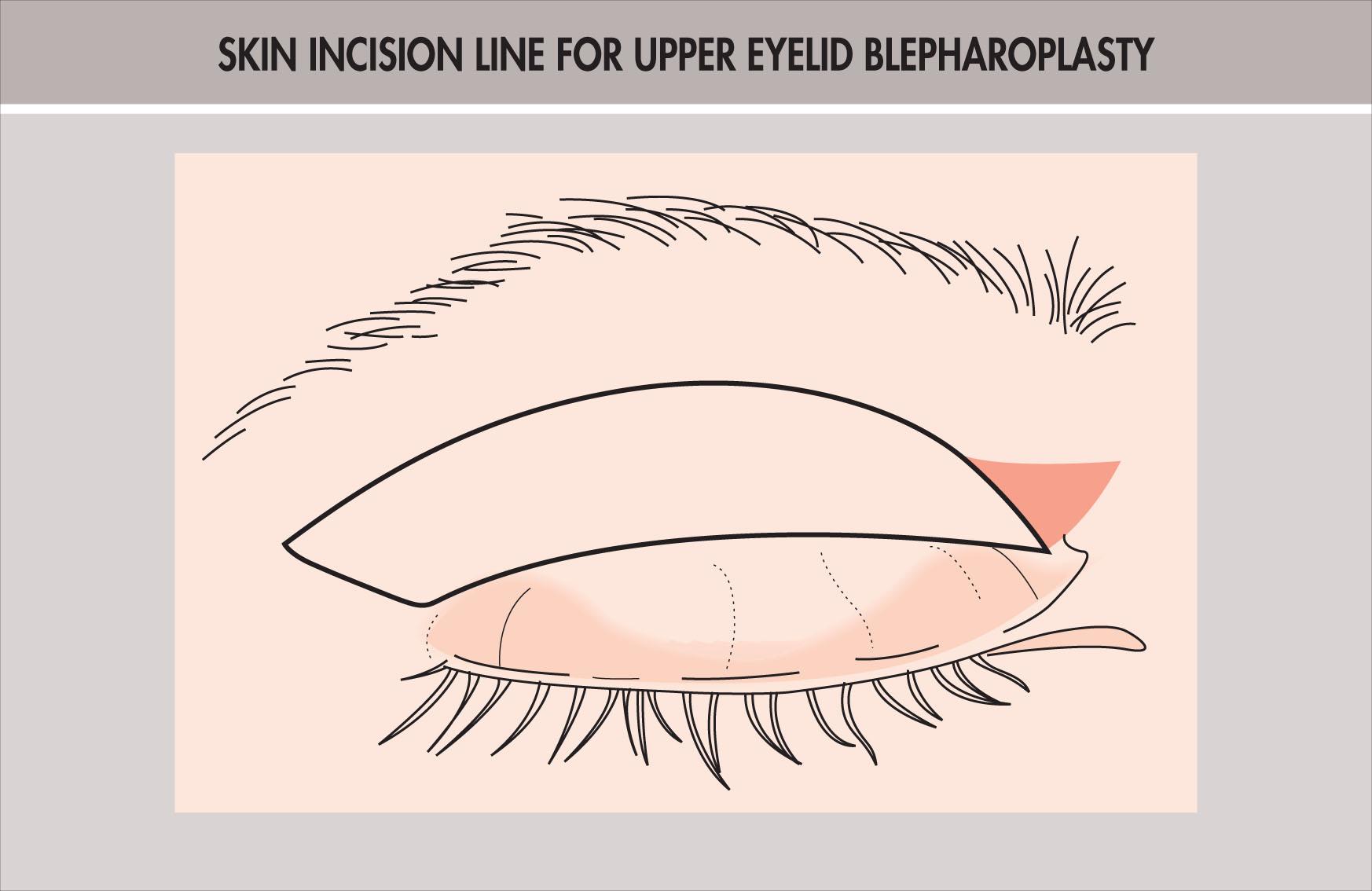
The lid is placed under downward traction, and a Bard–Parker No. 15 blade is used to incise the skin. The skin flap is removed with a blade or scissors, leaving the orbicularis muscle intact at this stage.
Gentle pressure on the globe will prolapse the orbital fat pockets that bulge behind the orbicularis muscle and orbital septum. The fat is exposed by a small buttonhole that is made centrally through the orbicularis and the septum above its insertion on the aponeurosis. The septum is opened laterally and medially from this buttonhole ( Fig. 12.15.6 ). Each fat pad capsule is opened. The fat is gently prolapsed and transected. The section line is cauterized with a bipolar cautery (see Fig. 12.15.6 ).
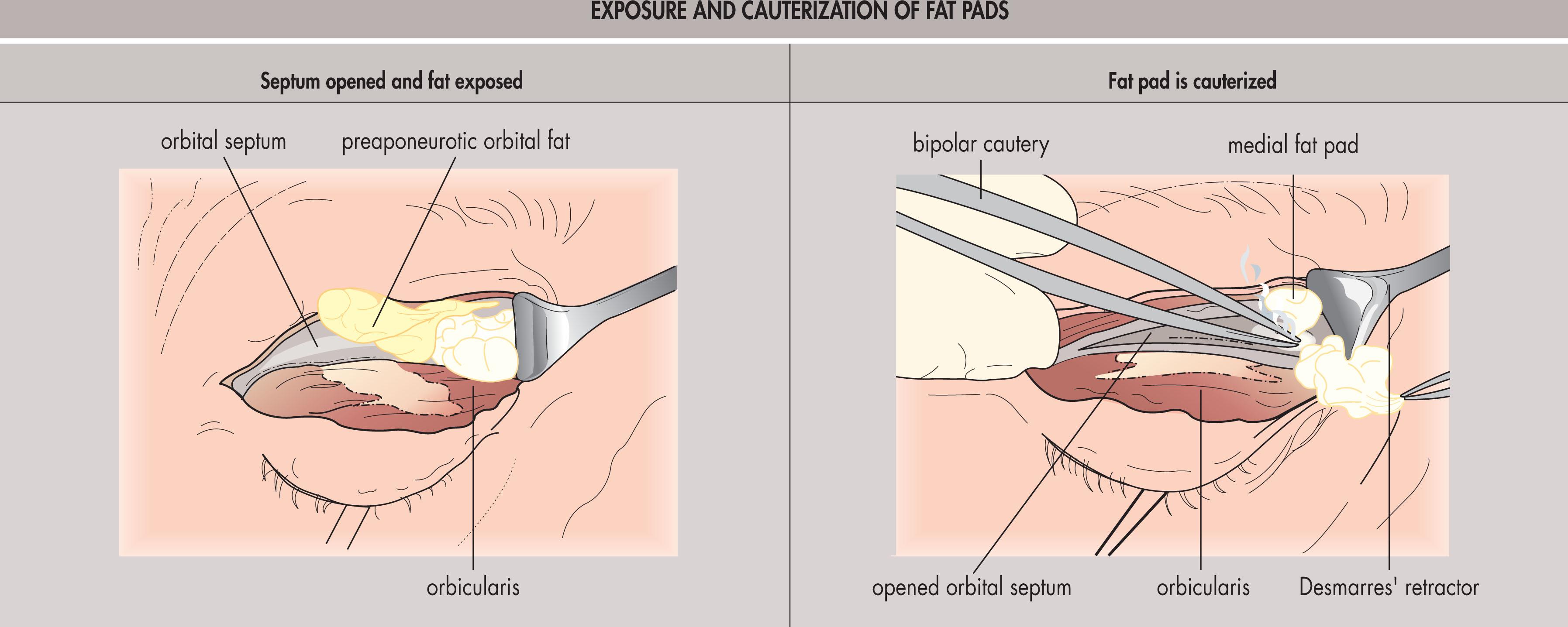
The orbicularis muscle is thinned, but some surgeons prefer to remove it completely along with the overlying skin. The aponeurosis is exposed above the tarsal border. Invagination of the skin by fixing the skin edge to the aponeurosis at the time of closure ensures a good position of the crease in fuller lids but is not always necessary. The orbicularis can be tacked down to the aponeurosis immediately under the upper skin edge using two or three 6–0 plain sutures. This defines the position of the eyelid crease and controls the position of the fat pad in the lid ( Fig. 12.15.7 ). The skin is closed with a running 6–0 nylon or 6–0 plain gut suture. The area beyond the lateral canthal angle is closed with interrupted sutures to obtain an edge-to-edge closure without folds ( Fig. 12.15.8 ).
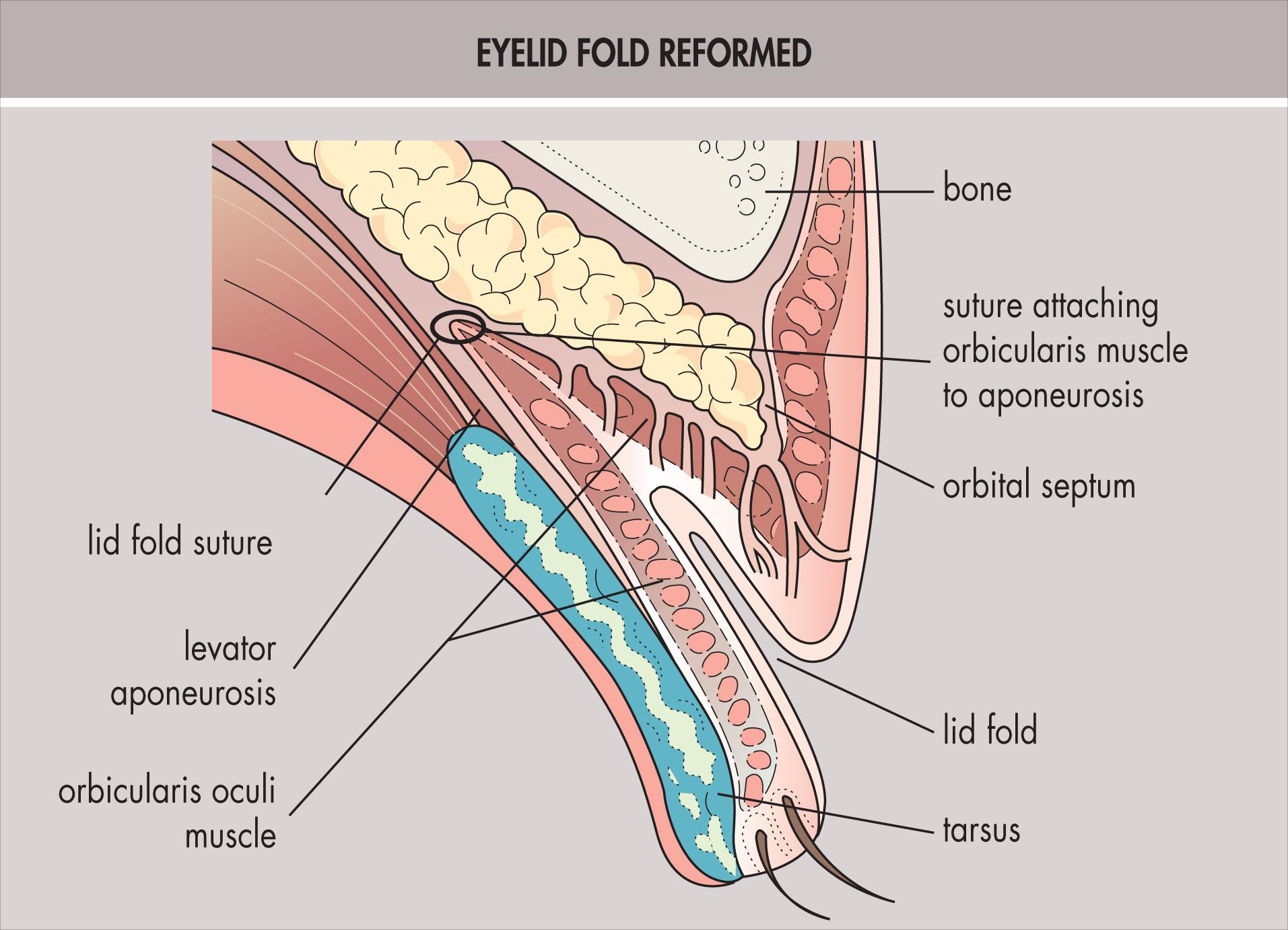
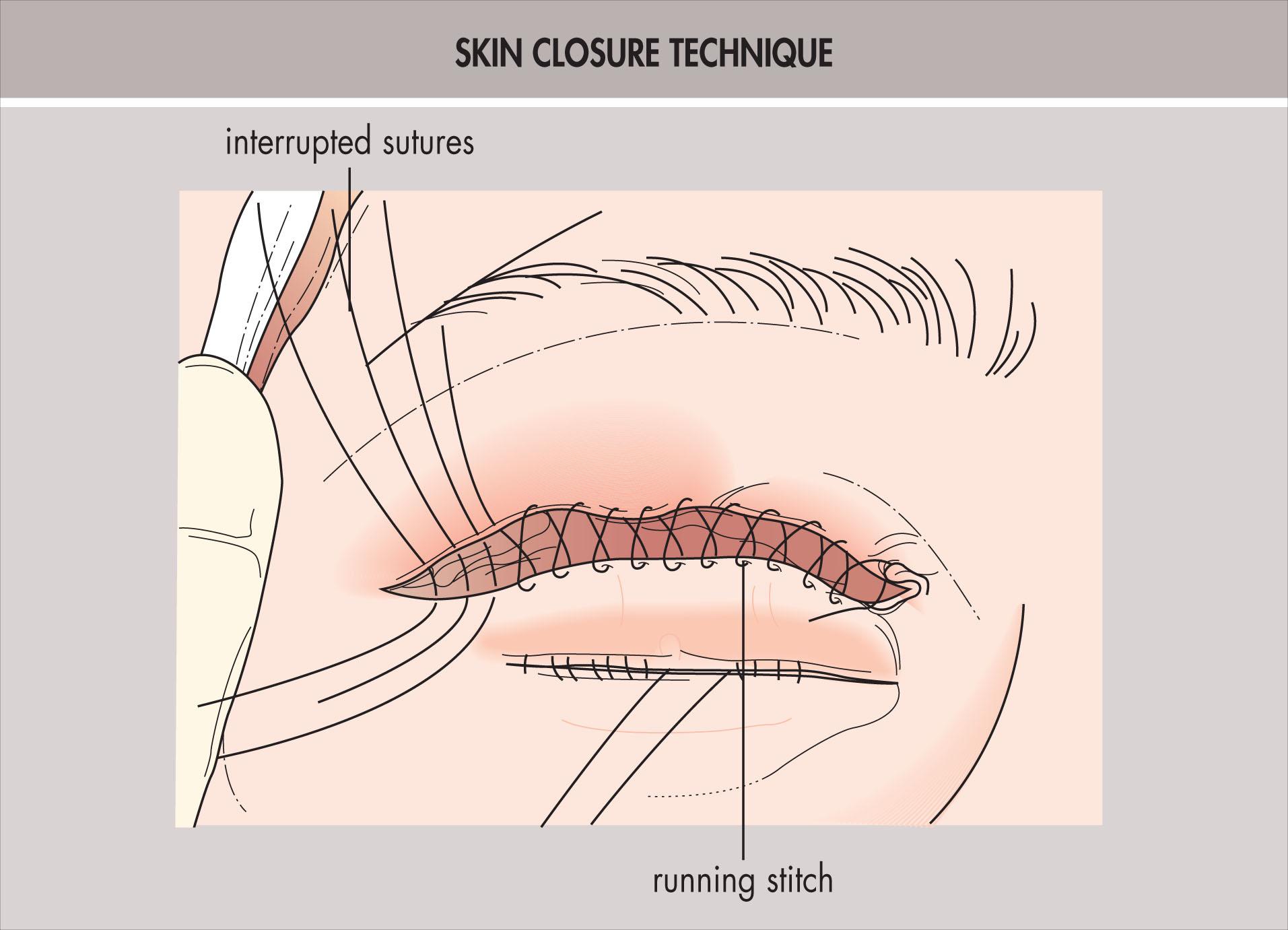
Become a Clinical Tree membership for Full access and enjoy Unlimited articles
If you are a member. Log in here